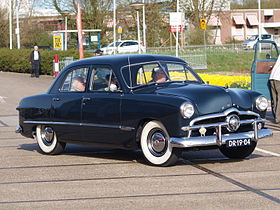1949 Ford
| Ford | |
|---|---|

1949 Ford Custom Fordor Sedan
|
|
| Overview | |
| Manufacturer | Ford |
| Production | 1949–1951 |
| Assembly |
Dearborn, Michigan Chester, Pennsylvania Long Beach, California Saint Paul, Minnesota United States Australia Singapore, Malaysia |
| Body and chassis | |
| Class | Full-size Ford |
| Body style | 2-door sedan 4-door sedan 2-door coupe 2-door hardtop 2-door convertible 2-door station wagon 2-door coupé utility (Australia) |
| Layout | FR layout |
| Related | 1949 Mercury Eight, Lincoln EL-series |
| Powertrain | |
| Engine | 226 CID (3.7 L) L-head I6 239 CID (3.9 L) Flathead V8 100 HP |
| Dimensions | |
| Wheelbase | 114 in (2,896 mm) |
| Length | 196.8 in (4,999 mm) |
| Width | 71.7 in (1,821 mm) |
| Curb weight | 3,110–3,770 lb (1,410–1,710 kg) |
| Chronology | |
| Predecessor | 1941 Ford |
| Successor | 1952 Ford |
The 1949 Ford was an American automobile produced by Ford. It was the first all-new automobile design introduced by the Big Three after World War II, civilian production having been suspended during the war, and the 1946-1948 models from Ford, GM, and Chrysler being updates of their pre-war models. Popularly called the "Shoebox Ford" for its slab-sided, "ponton" design, the 1949 Ford is credited both with saving Ford and ushering in modern streamlined car design with changes such as integrated fenders and more . The design would continue through the 1951 model year.
After sticking with its well-received previous model through model year 1948, Ford completely redesigned its namesake car for the year 1949. Save for its drive-train, this was an all-new car in every way, with a modern ladder frame now supporting a coil spring independent suspension in front and longitudinal semi-elliptical springs in back. The engine was moved forward to make more room in the passenger compartment and the antiquated "torque tube" was replaced by a modern drive shaft. Ford's popular 226 CID (3.7 L) L-head straight-6 and 239 CID (3.9 L) Flathead V8 remained, now rated at 90 hp (67 kW) and 100 hp (75 kW), respectively.
The 1949 models debuted at a gala at the Waldorf-Astoria Hotel in New York City in June 1948, with a carousel of the new Fords complemented by a revolving demonstration of the new chassis. The new integrated steel structure was advertised as a "lifeguard body", and even the woody wagon was steel at heart. The convertible frame had an "X member" for structural rigidity.
...
Wikipedia
